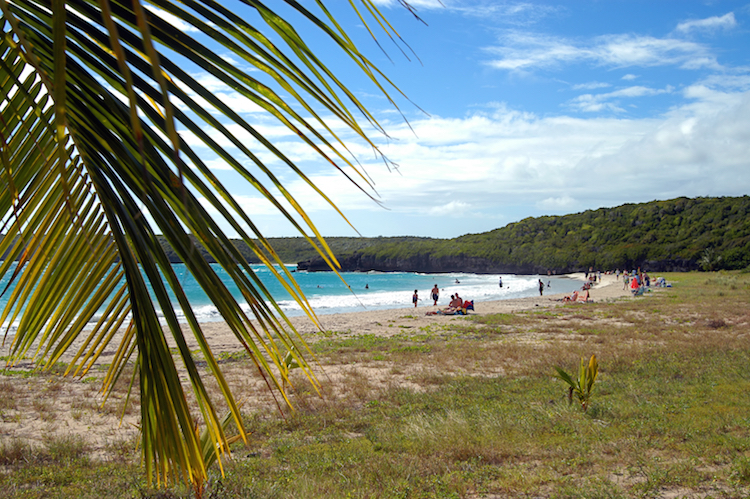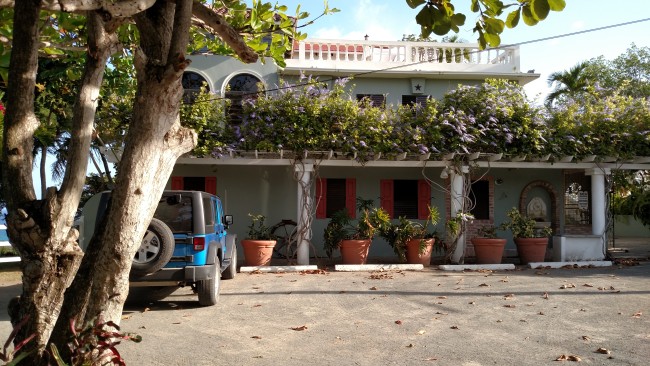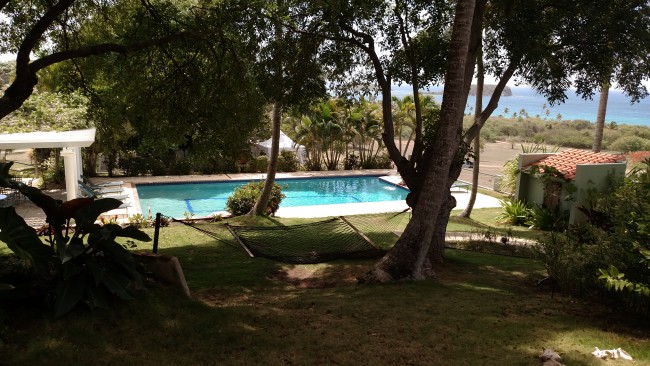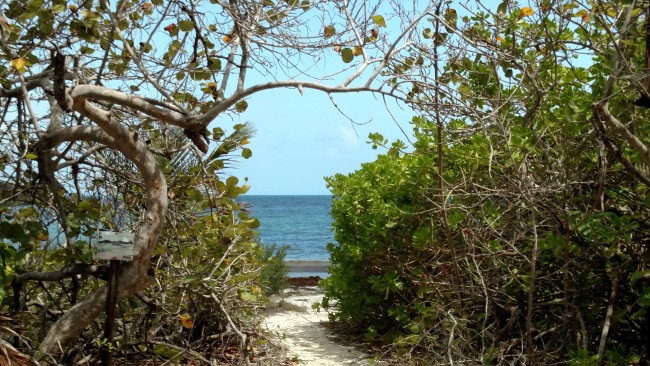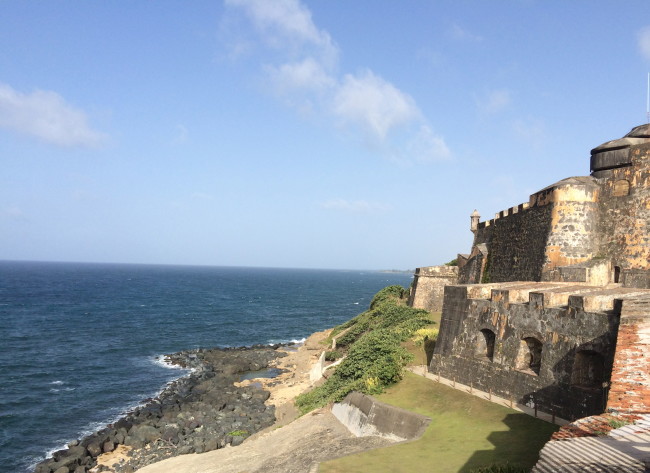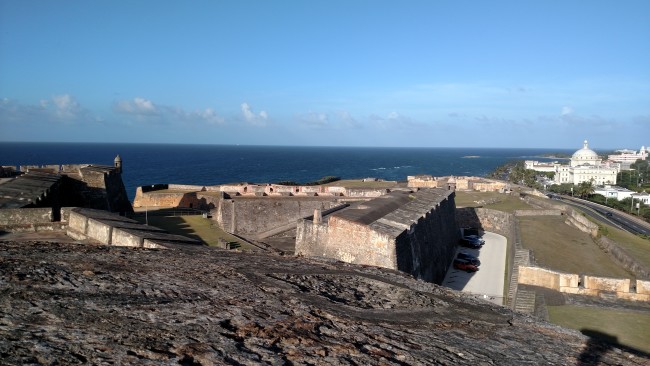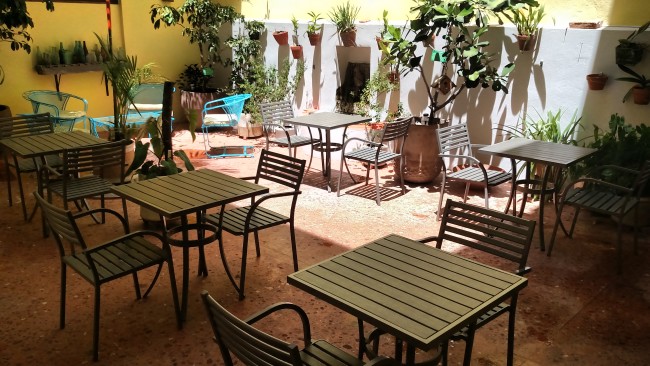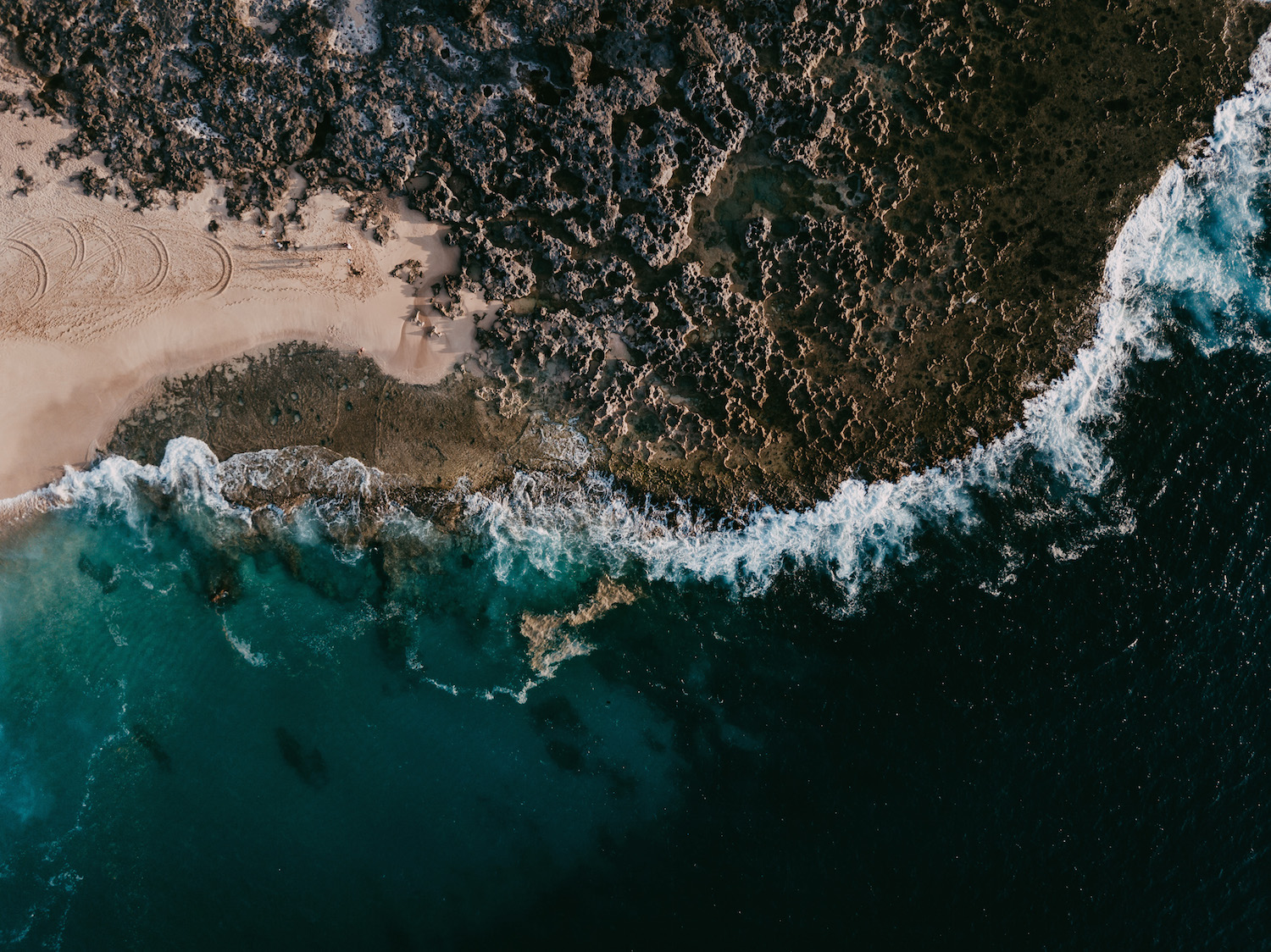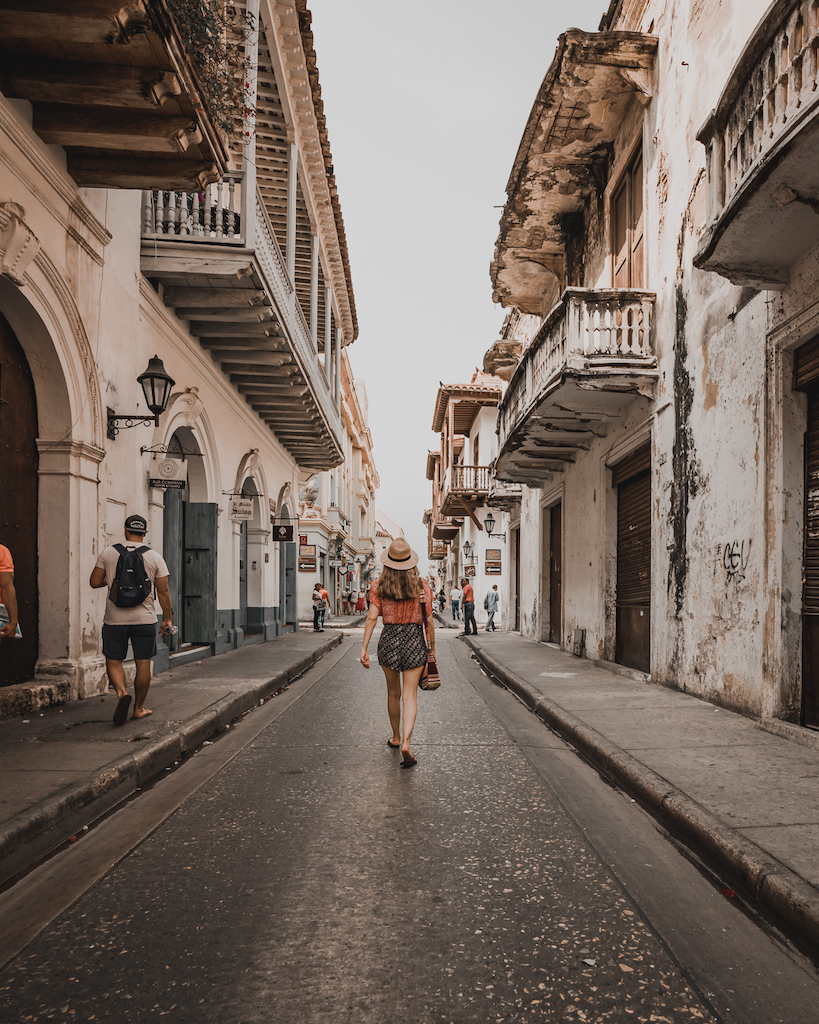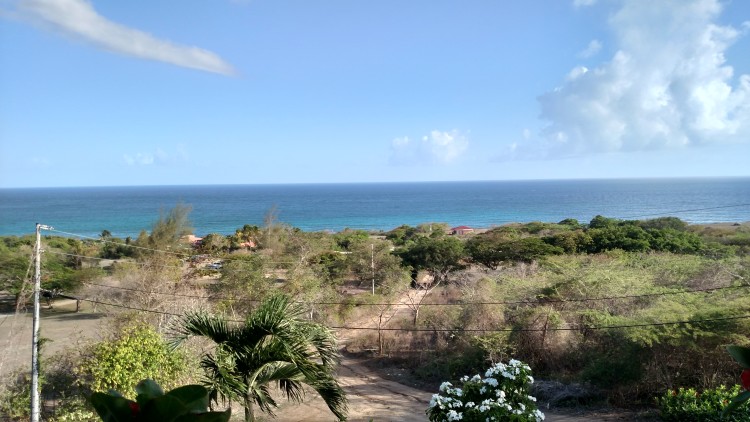 View of Caribbean Sea from Hacienda Tamarindo
View of Caribbean Sea from Hacienda Tamarindo
BY VICTORIA GAFFNEY
We bobbed up and down on our seven-person puddle-jumper, the high-rise hotels and casinos falling behind while hills began to roll into view beneath us. From this height, I saw a patchwork of sage and forest green blanketing the landscape, occasionally making room for clusters of white houses. I watched as the sea-foam waves crashed along the crescent shore and the verdant terrain disappeared from sight. Ahead, a swath of land I assumed must be Vieques, the 21-mile long island off the coast of Puerto Rico, came into view.
Vieques is steeped in a complicated past that began in 1942 when the U.S. Navy started using 80% of the island’s land as a bombing range. Tensions rose over the years with protests breaking out in the late 1990s until, on May 1, 2003, the U.S. Navy handed over their 22,000 acres to the US Fish and Wildlife Service. The Navy’s 60-year occupation was formative for this sliver of land off the coast of the main island of Puerto Rico. Many point out that, paradoxically, the Navy’s presence preserved the island’s state as a relatively undeveloped and isolated haven of white sand beaches, dense forests, and cyan waters.
From Vieques’ miniature airport we taxied to Maritza’s Car Rental where we picked up our cobalt jeep wrangler; four wheelers are essential in order to access the remote beaches on the island, which are found at the end of long, winding dirt paths. We drove our jeep hesitantly around the frequent bends in the road—which, thankfully, happened to be paved—to Esperanza, one of two towns on the island. Stopping for a brief bite at Trade Winds along the promenade known as the Malecon, we watched a car drive past with speakers attached to its roof emanating an announcement in Spanish.
“That’s our local dissemination of information,” the woman next to us, an ex-pat from California, informed us. With no radio station or local paper, this appeared to be the means of sharing news in Vieques.
We drove over to Hacienda Tamarindo, our home for the next two nights located on the Southern side of the island. The Spanish style building was formerly a dance hall and is perched on a hill overlooking the Caribbean Sea. As we walked towards the lobby a bundle of white and gray fur—the Old English Sheepdog, Zach—greeted us with Burr Vail, who owns the bed and breakfast with his wife Linda, following close behind.
Hacienda Tamarindo is built around a 250-year-old Tamarind tree that stretches up through the center of the lobby, extending its branches over the open-air second floor where its leaves cast playful shadows on the walls and furniture in the dining area. With its relaxed but elegant décor, the Vail’s bed and breakfast seems to blend Linda’s interior designer’s eye with Burr’s sense of humor. Antiques fill various spaces in the rooms while vintage signs hang from the walls, including funny sayings like “Gentle dog, beware of owner.”
The 16-room villa is brimming with thoughtful amenities. A serene pool nestled at the bottom of a slight incline provides views of the ocean, while a small shed known as the “beach shop” contains anything you might need for a day in the sun, including sunblock and free beach chairs. Perhaps most endearing is the “honor bar,” where you can mix yourself a drink in a quaint library filled with great books.
On our trip nothing quite compared to the view from the room. Each morning I would peak through the wooden slats on the windows and the French doors leading to the balcony. The rising sun’s bright light would sneak in through the empty spaces between the wood and a gentle glow would permeate our room. Once I opened the doors, light swarmed around our space, the breeze carrying a recognizably briny scent with it. After my eyes adjusted I would begin to take in the green pastures sloping down to greet the azure sea glistening in the sunlight.
While we were staying in Puerto Rico this August, the island was experiencing its worst drought in twenty-five years. Hacienda Tamarindo’s number of eco-friendly initiatives felt particularly relevant in this climate. In addition to having low-flow showerheads and low-volume toilets, the Vail’s bread and breakfast has soap and shampoo dispensers in the showers to minimize product and packaging waste. Acknowledging the importance of individual responsibility, there are also signs requesting that guests hang up any towels that can be reused and that they turn off lights and air conditioning when they leave. Much of the breakfast fruit is local and there is a compost pile next to the beach shop.
When talking with Burr, he emphasizes the importance of eco-education. He and Linda send their grandson to an eco-camp in Vieques every summer called “MANTA,” where the campers snorkel and learn about the ocean’s ecosystem, among other environmental activities. Burr told us that one time his grandson was playing with his friends and jumping off of the pier; while splashing in the sea, he told his friends all about the coral and different things he learned. This kind of excitement about the environment and conservation is key to stimulating lasting change on the island and in Puerto Rico.
[easy-tweet tweet=”Vieques and Old San Juan feel like spaces frozen in time, places somehow immune to change. ” user=”thecultureist” hashtags=”#travel”]
For the next three days, we would take bumpy rides down dirt roads as Paso Fino horses—a breed of horse the Spanish initially brought over—crossed directly in front of us or grazed in thickets of dense trees. Our jeep led us to a variety of beaches—from the popular Sun Bay to the more secluded La Chiva—all different in their quality of sand (which ranges from fine to rough, white to black) as well as the depth and color of water. Whatever beach we happened to be on, we were often one of a few, if not the only, people enjoying a private expanse of sand and sea.
I quickly found that Vieques is more than just its beaches. Throughout our stay, we’d stumble upon a fascinating archeological site, Puerto Ferro, hike up El Fortin Conde de Mirasol, and kayak in a glass bottom boat with JAK’s Water Sports in Mosquito Bay, one of the Puerto Rico’s three bioluminescent bays. The bays are filled with a type of plankton that, when disturbed, transform the space around them into radiant streams and orbs of white that appear to glow. I’d watch the oars carve brilliant pathways in the navy waters while below a series of racing white sparks seemed to reflect the stars above in the night sky.
Breakfast at Hacienda Tamarindo comprised of fresh fruit, coffee, and an expansive menu with all types of delicious options—from American-style pancakes to Puerto Rican-flavored home fries, or papas, which were my favorite. While eating one morning we jumped at the sound of a thump. Turning we saw a Tamarind fruit had just fallen to the ground and narrowly missed Burr’s head. “Good thing it wasn’t an apple,” he laughed. That morning we tried Tamarind juice, which I was surprised to find tasted a bit like prune juice.
We had to cut our visit to Vieques short because of an impending hurricane that had weakened to a tropical storm. Taking one of the last flights off the island for the next few days, we hopped back across the ocean, and I watched our diminuitive Vieques—the island suffused in a gentle ocean breeze and the calming scent of saltwater—disappear from view. Thirty minutes later we landed in the small airport of Isla Grande in San Juan, and took a taxi to our next stop.
OLD SAN JUAN
Juan Ponce de Leon founded the first Puerto Rican Spanish settlement in 1508. Before long, the Spanish moved to a new site, which they named “Puerto Rico,” or “rich port,” adding the name “San Juan” in 1521. Old San Juan abounds with architectural gems from the 16th and 17th centuries, often displaying a rich combination of medieval, gothic, and baroque styles. From the three major forts—La Fortaleza, Castillo San Felipe del Morro, and Castillo San Cristóbal—to the myriad museums and pastel-colored houses, Old San Juan is an ideal place to see on foot.
As our taxi took us down impossibly narrow side streets, I began to realize that we had simply traded in the rough dirt paths of Vieques for the cobblestones of Old San Juan. For the next three days we would explore the history of this old Spanish settlement at a slow, methodical pace.
When we turned onto Calle Sol I knew that Casa Sol, our small colonial style bed and breakfast, would be coming up somewhere on the left. We soon saw its sunny yellow façade beaming amid a row of colorful houses. Stepping through the old-fashioned gate and into the hall, I felt transported to a different century. When I saw the imposing dark wooden doors and the breezy open courtyard, I realized this place was a fitting home-base for our journey to the past.
Located on Calle Sol and powered by the sun, Casa Sol is aptly named. Eddie Ramirez, who has been in the hotel industry for 30 years, and his wife, Tisha Pastor, who is an interior designer, had the idea to start a bed and breakfast in Old San Juan for a while. One day in 2011 Tisha was walking down Calle Sol when she saw a “For Sale” sign on Casa Sol. The house was a former apartment building, but had been abandoned for years and dated back to the 18th century when it served as a base for Spanish soldiers from Castillo San Cristóbal.
Eddie and Tisha knew the layout of the building was perfect for a five-room bed and breakfast, and they promptly got to work. The architect Billy Ramirez Castellano, Eddie’s brother, helped to restore the building’s original Spanish colonial look. During the restoration process, they used a lot of the materials from the old building itself. Most of Old San Juan’s buildings have old cisterns beneath them from the Spaniards, Eddie told us. When he and his team dug under Casa Sol they found the building’s old well and cleaned it out. You can see vestiges of its contents in the courtyard today. Above Tisha’s grandmother’s 70-year-old teal patio furniture, colorful bottles that had been in the cistern for years contribute to the artisanal vibe of Casa Sol, while also serving as an ode to the building’s past. Eddie also used teak wood from the deck of an old ship to make the doors for the rooms.
Casa Sol’s high ceilings give the rooms an airy feel and the ironwood beams reinforce the colonial style. Each room is decorated with local artwork and designed in the spirit of an Old San Juan neighborhood. Ours, “La Perla,” featured an abstract painting of reds, blues, and yellows evoking the graffiti in the actual neighborhood. On our bed sat a mermaid doll with royal blue hair. Eddie and Tisha’s friend makes these whimsical dolls, which are specifically designed for their future owners. For Casa Sol, she walked into each room to get a sense and feeling before setting out to make dolls that captured the space. Each of the dolls comes with a little booklet that tells her story.
It’s details like these that make Casa Sol such a special place. Eddie and Tisha are genial hosts who like to devote time to their family and guests, and they are passionate about eco-tourism.
“Conservation is our lifestyle,” Eddie explained. “We want to keep our footprint as minimal as possible.”
Casa Sol embodies this eco-friendly spirit in a number of ways, from the “five-minute” hourglass timers that challenge you to take a five-minute shower, to the solar panels, to the method for collecting rainwater that flows into the old cistern. Casa Sol is recognized for their sustainable initiatives and has earned a Green Key label.
Wanting to support local businesses, Eddie and Tisha get their baked goods for breakfast from an old bakery, “La Heresana,” and their milk from a little store around the corner. A neighbor who owns a small laundry service takes care of their linens. Eddie is also involved with Puerto Rico Hotel and Tourism Industry’s STEPS (Sustainable Tourism and Environmental Performance Stewardship) program, which helps hotels work towards sustainability and an environmental mission (Hacienda Tamarindo recently enrolled in the program). Eddie is dedicated to conserving the environment and, like Burr, recognizes the importance of education. It’s all about changing the culture.
Breakfast at Casa Sol is different everyday. Tisha made us our first: delicious eggs scrambled with fresh vegetables and fruits—mangos, pineapples, bananas, and papaya. The other two mornings Eddie prepared waffles with a delectable cherry sauce and an omelet with plantains. Tisha’s brother owns a nearby café, Finca Cialitos, and everyday I had some of his rich coffee with my breakfast. On our last day, Eddie gave us a bowl with casiños, a sweet fruit popular among children. He explained to us that you eat the skin and suck on the seeds. Later that morning, I happened to notice beautiful black, white, and yellow birds flying around the courtyard, and recognized them as the same birds I saw playing in the birdbath at Hacienda Tamarindo.
“What are those called?” I asked Eddie.
“Renitas,” he told me, or “little queens.”
Casa Sol is not for the sunbathing, casino-seeking tourist. Eddie said that guests sometimes ask him about the pool (there isn’t one) or the TV’s (there aren’t any). One couple in particular complained about the lack of a TV in their room. Eddie told them that in place of TV they should just sit on their bed and imagine a time when soldiers marched along Calle Sol, making it one of the noisiest streets in Old San Juan. Listen for the sound of their steps, he implored them, and “let history take you back in time.” The couple had been married 30 years and had never talked more than they had that night. After their trip they sent Eddie a note that read: “We took the TV out of our bedroom.” This is the kind of difference Eddie wants to make—he wants to create lasting experiences for his guests.
Both Vieques and Old San Juan feel like spaces frozen in time, places somehow immune to change. Whether watching the cerulean sea with patches of turquoise and jade lap the soft powdery sand in Vieques or walking down a cobblestone street with polychromatic houses and plazas in Old San Juan, my week in Puerto Rico invited me to slacken my pace to a thoughtful amble. As I roamed—in a four-wheeler or on foot—I took in the astonishingly preserved natural landscape and listened for the footsteps of the past.
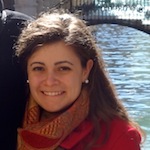 ABOUT THE WRITER
ABOUT THE WRITER
Victoria Gaffney is currently pursuing an MA in Nonfiction Writing at Johns Hopkins in Washington D.C. She is a graduate of Haverford College where she majored in English and developed a passion for words and stories. She enjoys traveling and engaging with new people and perspectives, and relishes the thrill of late nights spent reading a new book or huddling in front of a computer screen to write. In her free time, she can be found drinking copious amounts of coffee, playing with dogs, practicing yoga and wandering around new streets without a plan. Victoria hopes to use writing to help impact positive change. Follow her on Twitter.
Thank you to Hacienda Tamarindo and Casa Sol for sponsoring our stay. Photos by Victoria Gaffney.
Featured photo of Vieques via Shutterstock
